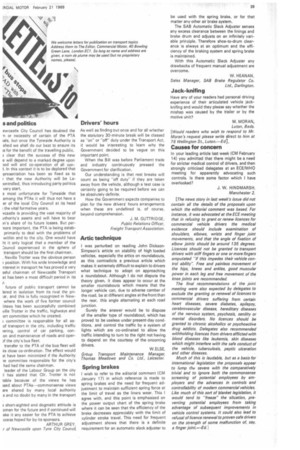Artie technique
Page 41

If you've noticed an error in this article please click here to report it so we can fix it.
I was perturbed on reading John DicksonSimpson's article on stability of high loaded vehicles, especially the artics on roundabouts, as this contradicts a previous article which makes it extremely difficult to explain to drivers what technique to adopt on approaching a roundabout. Although I do not dispute the theory given, it does appear to occur at the smaller roundabouts which means that the longer vehicle can, due to adverse camber of the road, be at different angles at thefront than the rear, this angle alternating at each road junction.
Surely the answer would be to dispose of the smaller type of roundabout, which has proved to be useless under present-day conditions, and control the traffic by a system of lights which are co-ordinated to allow the traffic intending to turn to the right not having to depend on the courtesy of the oncoming drivers, W.ELSE, Group Transport Maintenance Manager, Thomas Meadows and Co. Ltd., Leicester.
Spring brakes
I wish to refer to the editorial comment ;CM January 17) in which reference is made to spring brakes and the need for frequent adjustment to maintain sufficient spring force at the limit of travel as the liners wear. This I agree with, and this point is emphasized on the power output chart of the spring brake where it can be seen that the efficiency of the brake decreases appreciably with the limit of cylinder stroke travel. This need for frequent adjustment shows that there is a definite requirement for an automatic slack adjuster to be used with the spring brake, or for that matter any other air brake system.
The SAB Automatic Slack Adjuster senses any excess clearance between the linings and brake drum and adjusts on an infinitely variable principle. Therefore shoe-to-drum clearance is always at an optimum and the efficiency of the braking system and spring brake is maintained.
With this Automatic Slack Adjuster any drawbacks of frequent manual adjustment are overcome.
W. HEANAN, Sales Manager, SAB Brake Regulator Co. Ltd, Darlington.
Jack-knifing
Have any of your readers had personal driving experience of their articulated vehicle jackknifing and would they please say whether the mishap was caused by the trailer or by the motive Unit?
M. MORAN, Luton, Beds. [Would readers who wish to respond to Mr. Moran's request please write direct to him at 76 Wellington St., Luton.--Edj.
Causes for concern
In your leading article last week (CM February 14) you admitted that there might be a need for stricter medical control of drivers, and then strongly criticized delegates at an ECENVHO meeting for apparently advocating such controls. Is there some factor which I have overlooked?
J. W. HINDMARSH, Manchester 2.
[The news story in last week's issue did not contain all the details of the proposals upon which the editorial comment was based. For instance, it was advocated at the ECE meeting that in refusing to grant or renew licences for commercial vehicle drivers the medical evidence should include examination of shoulders, elbows, wrists and finger joint movements, and that the angle of fixation of elbow joints should be around 135 degrees. Licences should not be granted to transport drivers with stiff fingers or one or more fingers amputated "if this impedes their vehicle control ability". Free and painless movement of the hips, knees and ankles, good muscular power in each leg and free movement of the knee joints are recommended.
The final recommendations of the joint meeting were also expected by delegates to exclude the granting or renewal of licences to commercial drivers suffering from certain heart diseases, severe diabetes, epilepsy, cerebro vascular disease, hereditary diseases of the nervous system, psychosis, senility or mental disorders. No licences should be granted to chronic alcoholics or psychoactive drug addicts. Delegates also recommended withholding licences from drivers afflicted with blood diseases like leukemia, skin diseases which might interfere with the safe conduct of the vehicle, tuberculosis, peptic ulceration and other diseases.
Much of this is laudable, but as a basis for international legislation the proposals appear to lump thd severe with the comparatively trivial and to ignore both the commonsense screening of potential employees by employers and the advances in controls and controllability of modern commercial vehicles. Like much of this sort of blanket legislation, it would tend to "freeze" the situation, preventing potential employees from taking advantage of subsequent improvements in vehicle control systems. It could also lead to refusal of licence renewal to proven safe drivers on the strength of some malfunction of, say, a finger joint—Ed.}












































































































